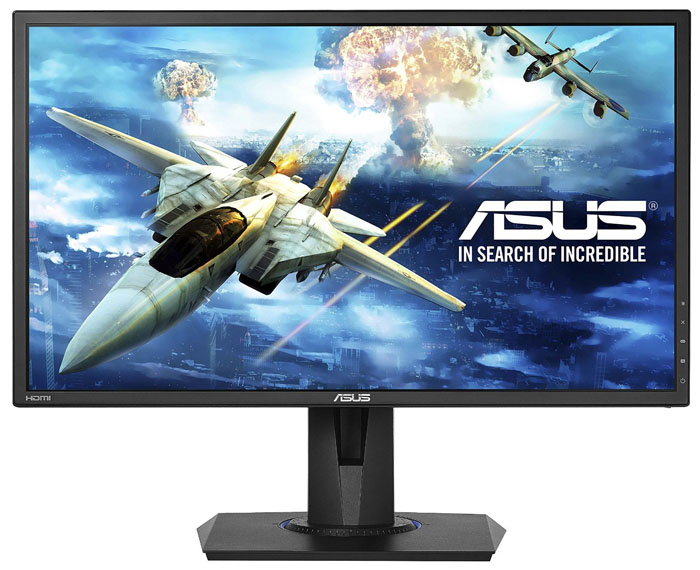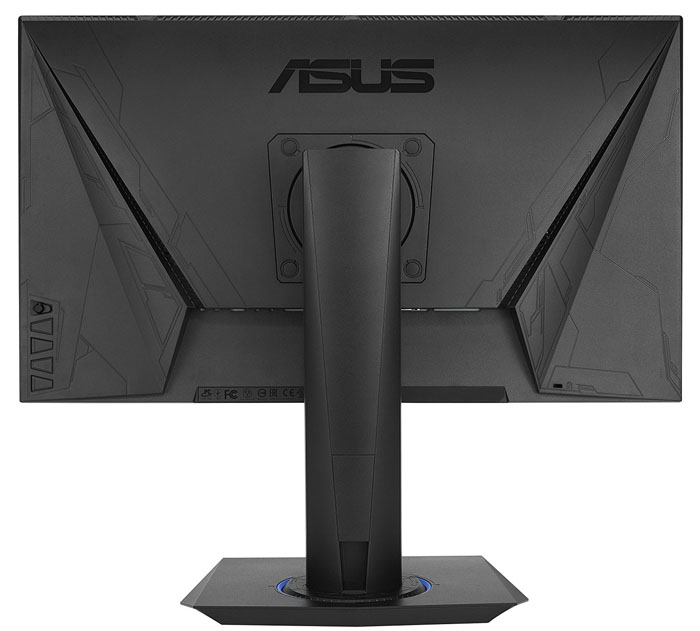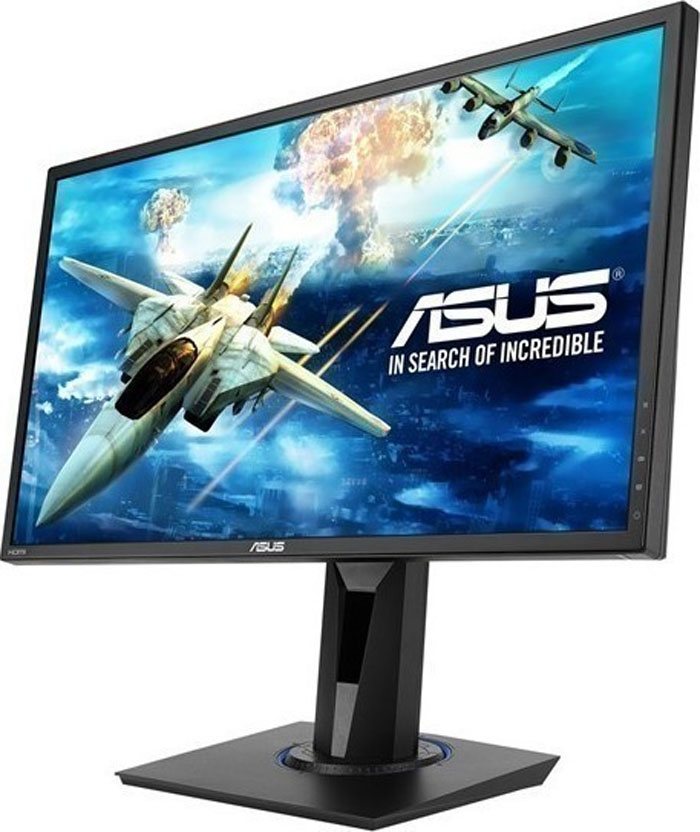Early Verdict
For less than two-hundred bucks, the Asus VG245H is pretty much in a class by itself. While that probably won’t be the case for long, this monitor makes a super-attractive choice for buyers on a budget. It offers all the build quality and features of more-expensive displays while only giving up refresh rate to the competition. If you have a low to mid-grade system, it’s an ideal match. Highly Recommended.
Pros
- +
FreeSync
- +
Image quality
- +
Build quality
- +
OSD joystick
- +
GamePlus
- +
Value
Cons
- -
75Hz refresh rate
- -
Adjustments required for max performance
Why you can trust Tom's Hardware
Introduction
We cover a lot of cool new display technology, but regardless of how important or significant they are, the principal subject we see in reader discussions is price and value. The gaming monitor category is especially rife with expensive displays thanks to customer demands for things like high refresh rates, greater pixel density, IPS panels, and, of course, adaptive refresh.
We all know about the price divide between Nvidia’s G-Sync and AMD’s FreeSync. The latter is found more commonly in value-oriented displays, while the former has become the norm for premium products. Today we’re checking out a new value-leader in the 24" category: the Asus VG245H.
Specifications
The VG245H represents something of a price breakthrough among 24" gaming screens. It’s the first one we’ve seen from a major manufacturer that cracks the $200 mark. And it doesn’t cut too many corners to achieve a competitive price. The panel is a TN part, which probably comes as no surprise, but it offers 8-bit color without FRC and a white LED backlight that’s flicker free. Resolution is 1920x1080, which means a reasonable pixel-density of 92ppi.
In addition to FreeSync, which operates over HDMI here, the refresh rate tops out at 75Hz. With much of the competition offering 144Hz, this is the only significant difference between the VG245H and other 24" gaming monitors. Adaptive sync works over a range of 40-75Hz, which means Low Framerate Compensation (LFC) is not possible. For that, the max rate must be at least 2.5X the minimum.
The remaining features are pretty much the same as what we found on the more expensive PG248Q. You get the same GameVisual picture modes, GamePlus, a slick OSD joystick for easy setup, and four memory slots to save your personalized configurations. For just under $200, this looks like a great package. Let’s take a closer look.
Packaging, Physical Layout & Accessories
To extract the VG245H from its carton, you’ll have to slide the entire package out like a drawer. There are two large foam blocks keeping everything secure. Assembly consists of attaching the base to the upright with a captive bolt.
Included cables are HDMI, VGA, analog audio, and a tiny external power supply. You also get a quick start guide and warranty card. The full User Guide can be downloaded from Asus’ website.
Get Tom's Hardware's best news and in-depth reviews, straight to your inbox.
Product 360



The VG245H presents a trim appearance with a slim 13mm bezel that’s nearly flush with the anti-glare layer. While it’s not especially narrow, the tight mounting style means you’ll barely notice the division between screens in a multi-monitor setup. That precision is further aided by an alignment guide available in the GamePlus menu. The front of the screen doesn’t pick up stray reflections easily and provides a nice sharp image free of grain or other artifacts.
Controls are around back of the lower-right corner and consist of four buttons and a tiny joystick. It’s the same arrangement you’ll find on Asus’ premium screens, and it makes menu navigation super easy. There are no corners cut here as the keys click with a firm feel and positive response.
The stand offers tilt (38°), swivel (90° in each direction), height (130mm), and a portrait mode. Movements are just as high quality as the more expensive ROG PG248Q we just reviewed. Additionally, the height adjustment offers detents, so you can easily find your preferred position when the monitor is moved.
On the back you’ll find a bit of Asus’ sci-fi-tech styling with subtle lines molded into the plastic and a few interesting angles framing the input panel. The lines hide small grills which provide ventilation and a place for the stereo speakers. They play reasonably loud with minimal distortion, but their frequencies are restricted to the upper-midrange. Removing four screws detaches the upright and reveals a 100mm VESA mount.
The input panel is a first for us: a FreeSync monitor without DisplayPort. Adaptive refresh works over either HDMI input, and you’ll need to be sure to update AMD Catalyst if you happen to be running an older version like we were. There's also an analog audio input and a headphone output.
MORE: Best Gaming Monitors
MORE: Best Professional Monitors
MORE: How We Test Monitors
MORE: How To Choose A Monitor
MORE: All Monitor Content

Christian Eberle is a Contributing Editor for Tom's Hardware US. He's a veteran reviewer of A/V equipment, specializing in monitors. Christian began his obsession with tech when he built his first PC in 1991, a 286 running DOS 3.0 at a blazing 12MHz. In 2006, he undertook training from the Imaging Science Foundation in video calibration and testing and thus started a passion for precise imaging that persists to this day. He is also a professional musician with a degree from the New England Conservatory as a classical bassoonist which he used to good effect as a performer with the West Point Army Band from 1987 to 2013. He enjoys watching movies and listening to high-end audio in his custom-built home theater and can be seen riding trails near his home on a race-ready ICE VTX recumbent trike. Christian enjoys the endless summer in Florida where he lives with his wife and Chihuahua and plays with orchestras around the state.
-
ohim 75Hz should not have the "Gaming" Tag next to the product, this is Office class hardware territory, even with the FreeSync tech. I have 60Hz FreeSync monitor and i`m alwasy outside the range of Freesync.Reply -
-Fran- I was wondering... Is there a chance for Toms to include Monitor OC? I have a feeling this monitor, as it is out of the box, is not telling the whole story...Reply
In any case, thanks for the review. For the price, it doesn't appeal to me, TBH. Not even for mundane tasks/use.
Cheers! -
newton75x it is nice and everything but 75hz is a deal breaker for a gamer even in a low budget .Reply -
Michael_498 @Ohim: This is a nice sentence. One says it, the others copy it. Like in School. But let's think about it (which is different from School). If we synchronize the whole line from game over graphics Card to, finally, the Screen, we don't Need really more than 50-60 Hz because we cannot recognize it. More is only needed without Synchronisation, if it works the way I mentioned, which is still a long way to go for the industry. So be careful with your claims, especially with "even with G-Sync".Reply -
ohim Reply19027733 said:@Ohim: This is a nice sentence. One says it, the others copy it. Like in School. But let's think about it (which is different from School). If we synchronize the whole line from game over graphics Card to, finally, the Screen, we don't Need really more than 50-60 Hz because we cannot recognize it. More is only needed without Synchronisation, if it works the way I mentioned, which is still a long way to go for the industry. So be careful with your claims, especially with "even with G-Sync".
I know what i`m talking about since i own a product as such, do you ? I`m gaming on a 3440x1440 34" LG monitor with freesync in the range of 40 to 60. In games like Battlefield 1 at Ultra i have the game sitting in that range and it is ok, but every other game will be way outside this range and thus making the FreeSync useless, Gsync at 60 Hz is just as useless.
You might say turn v-sync on and/or cap frames at 60, that`s a no go, unnecessary input lag induced for the joy of smooth frames. If you play games competitively (you do call yourself a gamer and buy a gaming product) then you want as much FPS as you can get for fast reactions. Some might say what`s the point of 150 FPS if you have a 60 Hz monitor, it is all about input and reactions and it helps, so if you come with a 60Hz/75Hz monitor and call it a "gaming" monitor i will laugh in your face.
Manufacturers are milking the hell out of the "gaming" tag, at this point this monitor has nothing special about it, it`s a TN 24" monitor with added Freesync (this costs almost nothing to implement) so why ask 200$ for a monitor that is normally 100-150$ and doesn`t have anything to do with gaming ? -
Verrin I think the value here is fantastic, with FreeSync. I can understand that most people reading this are enthusiasts with bigger budgets and higher standards, but outside of this readership I don't think most people want to spend more than 150-200 dollars on a monitor.Reply -
-Fran- Reply19028432 said:I think the value here is fantastic, with FreeSync. I can understand that most people reading this are enthusiasts with bigger budgets and higher standards, but outside of this readership I don't think most people want to spend more than 150-200 dollars on a monitor.
And why would an enthusiast with a lesser budget want a Freesync monitor?
For that price you're 100 times better off with a non-Freesync 120Hz TN monitor like this:
https://www.amazon.com/Acer-GN246HL-Bbid-24-Inch-Display/dp/B00KO4518I/ref=sr_1_3?ie=UTF8&qid=1482255634&sr=8-3&keywords=120hz+monitor
Cheers!
